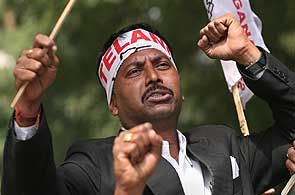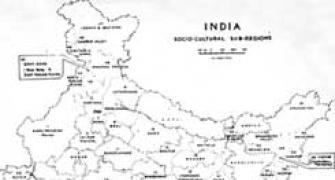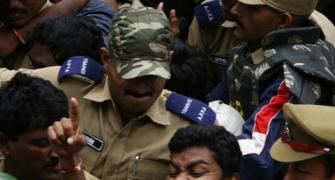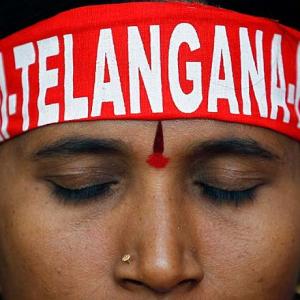 One can expect that the formation of Telangana will have more positives than negatives. The ‘Telangana effect’ has already prompted demands for a separate Vidarbha and break up of Uttar Pradesh. This needs to be considered seriously as this can only lead to deepening governance, says Colonel (retd) Anil Athale.
One can expect that the formation of Telangana will have more positives than negatives. The ‘Telangana effect’ has already prompted demands for a separate Vidarbha and break up of Uttar Pradesh. This needs to be considered seriously as this can only lead to deepening governance, says Colonel (retd) Anil Athale.
In India, the loose and unprofessional media often dubs movements for regional assertion as ‘separatists’ or even secessionist. The Telangana movement was for separation from Andhra Pradesh and not India.
This brings in an interesting hypothesis that to engender secessionism and related violent movements, more than one boundary has to coincide. In case of states in the north-east as well as Kashmir the geographic boundary also roughly corresponds to the racial and religious divide. Thus three divides coincide. In case of J&K, the geographical divide is reinforced by religious divide. Thus we can safely reason that when more than one boundary coincides there is a possibility of secessionist movement. Various boundaries and divides are necessary but it is not a sufficient precondition to generate an insurgency. Geography and its consequences create conditions of separate identity but it is the leadership and political organisations that catalyse it into a movement. Politics and the desire for power on the part of an individual and/or a group plays the role of a catalyst.
Telangana along with North Korea and Bengal is possibly the last bastion of orthodox Communism. The early years of freedom saw a violent Communist insurgency in Telangana. The budding revolution was effectively crushed by Jawaharlal Nehru using the police and the army. The nascent Communist party in later years morphed into the Maoists and Naxalites. Warangal district has been scene of some horrific and senseless killings including a train bombing in 1990. But Indian media is generally left oriented and soft on Naxals, so these have not been hyped like the killings in Gujarat.
There is a possibility that the new state of Telangana will be dominated by the Communists. It is a fact that most of the top leadership of Naxal movement in Chhattisgarh, Jharkhand and Odisha is from Telangana. In fact, this is fairly unique in the annals of the history of insurgency. (Though one must hasten to add that the leadership of Kashmir insurgency is also likewise in the hands of jihadis from Lahore!). Communism is akin to religion, with its own holy book (Das Capital), the Holy Trinity (Marx, Engels and Lenin) and the Holy Land, the erstwhile USSR (and now China).
But essentially, at the level of followers, the Communist movement was about securing economic rewards and therefore a ‘realist’ conflict with material goals. Thus despite the state boundaries of Telangana will also coincide with ideological boundary, a secessionist threat is unlikely to emerge.
Here the author wants to stick out his neck and predict that once Telangana is formed, the Naxalite leadership is likely to re-locate themselves to Telangana and abandon their role in other states. This is aided by the fact that the leadership is now mostly middle-aged, tired and under pressure. The formation of Telangana will thus have a favourable impact on the ongoing conflict in Chhattisgarh, Odisha and Jharkhand.
This author is an unabashed supporter of small states. The experience of Himachal Pradesh, Haryana, Uttarakhand and Chhattisgarh shows that a small state has led to better governance and faster economic development. This is so because in the Indian scheme of things the only ‘real’ devolution of power is at state level. As parts of large states, the areas of Himchal or Uttarakhand were politically irrelevant and often neglected.
There is a caveat though, and that is if a state is politically underdeveloped like Jharkhand, then there is no positive take away from the formation of a small state. The danger is real in case of Telangana as the spearhead of the movement the Telangana Rashtra Samithi is less of a political party and more a ‘family concern’ with close relatives of Chandrashekhar Rao occupying the top slots. But it is expected that the leftists and others like the Bharatiya Janata Party may well give a tough time to the TRS.
On balance one can expect that the formation of Telangana will have more positives than negatives. The ‘Telangana effect’ has already prompted demand for separate Vidarbha and break up of Uttar Pradesh. This needs to be considered seriously as this can only lead to deepening governance.
But we have to be also mindful of creating small and administratively non-viable states like Gorkhaland or Bodoland etc. In their case a better alternative would be make these into ‘Union Territories’. The advantage of UT status is that there is some check on proliferation of administration and expansion of bureaucracy. In small states like Himachal Pradesh or Mizoram, the bulk of revenue is spent on the salaries of government servants, a situation best avoided.
The creation of Telangana should be treated as opportunity to engineer India’s federal set up on more rational lines and not on historical baggage! In case of J&K for instance, there is strong case to give Jammu and Laadakh UT status. J&K is not even a linguistic state and if erstwhile Hyderabad can be split into Maharashtra, Andhra and now Telangana, why not J&K?
Colonel (retd) Anil Athale was Chhatrapati Shivaji fellow at the United Services Institution for study of insurgency.










